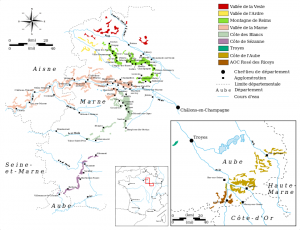| Alsace | Bordeaux | Burgundy | Champagne | Loire Valley | Rhône Valley |
- Situated in eastern France and is the coldest of France’s major wine regions
- Champagne wines can be both white and rosé
- A small amount of still wine is produced in Champagne (as AOC Coteaux Champenois) of which some can be red wine
- The primary grapes used in the production of Champagne are Chardonnay, Pinot noir and Pinot Meunier
Sparkling wines are produced worldwide:
- Spain uses cava
- Italy designates it spumante (from the muscat grape uses the DOCG asti)
- South Africa uses cap classique
- In Germany, Sekt is a common sparkling wine
- Other French wine regions cannot use the name Champagne, i.e. Burgundy and Alsace produce Crémant
- Most Champagnes are made from a blend of Chardonnay and Pinot Noir
- Blanc de blanc (“white from white”) Champagnes are made from 100% Chardonnay
- Blanc de noir (“white from black”) Champagne is pressed from Pinot Noir, Pinot Meunier or a mix of the two
- The dark-skinned Pinot Noir and Pinot Meunier give the wine its length and backbone
- Chardonnay gives the wine its acidity and biscuit flavor (especially when aged on the lees)
Rose wines of Champagne are produced by:
1. Leaving the clear juice of black grapes to macerate on its skins for a brief time (known as the saigneé method)
2. More commonly, by adding a small amount of still Pinot noir red wine to the sparkling wine cuvee
- Rosé Champagne is one of the few wines that allows the production of Rosé by the addition a small amount of red wine during blending (ensures a predictable and reproducible color from year-to-year)
Types of Champagne:
- Most of the Champagne produced today is “Non-vintage”, meaning that it is a blended product of grapes from multiple vintages
- Most of the base will be from a single year vintage with producers blending anywhere from 10-15% (even as high as 40%) of wine from older vintages
- Some producers will make a “Vintage” wine when the conditions were better that particular year (Has to be at least 85% from that “vintage” year)
- Under Champagne wine regulations, houses that make both vintage and non-vintage wines are allowed to use no more than 80% of the total vintage’s harvest for the production of vintage Champagne (saving the 20% for the non-vintage blends)
- A cuvée de prestige is a proprietary blended wine that is considered to be the top of a producer’s range (ex: Louis Roederer’s Cristal or Moët & Chandon’s Dom Pérignon)


 Masters of Wine
Masters of Wine Wine and Spirits Education Trust
Wine and Spirits Education Trust